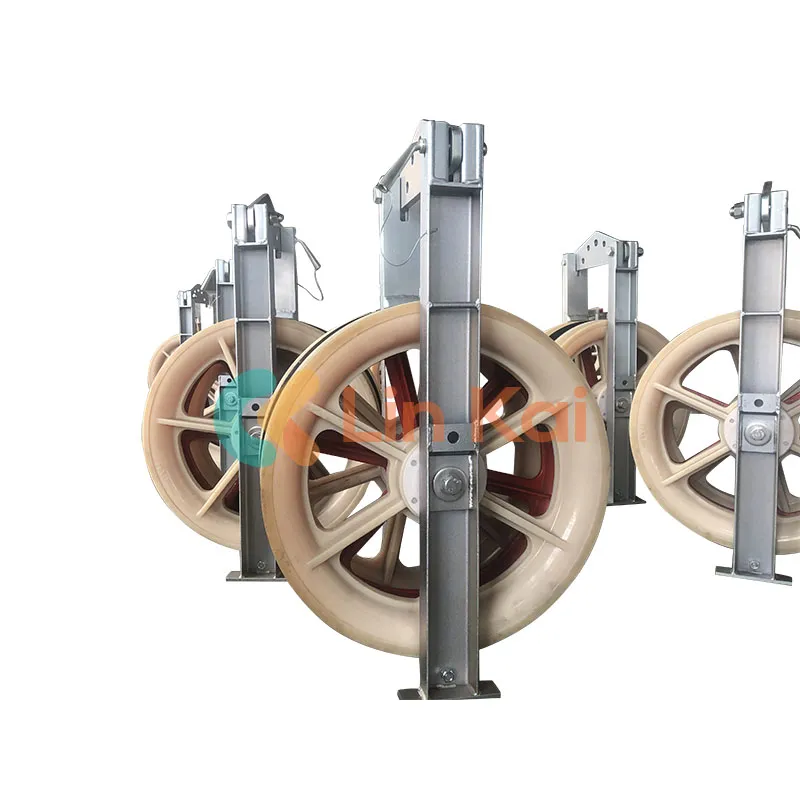Safety Precautions When Using Stringing Blocks
2024-11-06
Stringing blocks are crucial tools used in the installation of cables, particularly in overhead power lines, telecommunications, and other infrastructure projects. However, working with stringing blocks involves handling heavy cables and machinery, so it’s essential to follow proper safety precautions to prevent accidents and ensure the safety of workers. Below are key safety precautions to take when using stringing blocks:
1. Proper Inspection Before Use
- Check for Wear and Tear: Inspect the stringing blocks for any signs of damage, such as cracks, chips, or wear on the grooves or rollers. Ensure that the components, especially the bearing and groove linings, are in good working condition to avoid friction or failure during the cable pulling process.
- Verify Material Strength: Ensure the stringing blocks are made of appropriate materials (such as steel, composite, or reinforced plastic) for the specific type of cable being used, and that they are rated for the required load capacity.
- Lubrication: For blocks with roller bearings, ensure that the rollers are adequately lubricated to minimize friction and ensure smooth movement.

2. Safe Handling and Lifting
- Teamwork for Heavy Lifting: Stringing blocks, especially those used for high-voltage power cables, can be heavy. Always use proper lifting techniques or mechanical aids (such as cranes or hoists) when lifting stringing blocks, particularly when moving them into position on poles or structures.
- Personal Protective Equipment (PPE): Wear appropriate PPE such as gloves, steel-toe boots, safety glasses, and hard hats to protect against injuries during handling.
- Avoid Pinch Points: Be mindful of pinch points around the stringing blocks and cables, and always keep hands and fingers away from moving parts when the block is in operation.
3. Correct Installation and Positioning
- Secure Attachment: Always ensure that the stringing block is properly secured to a support structure (like a utility pole, tower, or frame) before use. Double-check that the attachment points, such as shackles or hooks, are correctly fastened and able to bear the load of the cable.
- Correct Alignment: Position the stringing block so that the groove or rollers are aligned with the path of the cable to avoid unnecessary friction or damage during the pull. Misalignment can cause the cable to become snagged or misdirected.
- Stability: Ensure the support structure is stable, and avoid using the stringing block if the structure is unstable or damaged.
4. Cable Management During Installation
- Monitor Cable Tension: Always monitor the tension on the cable to ensure that it does not exceed the maximum pulling capacity of the stringing block. Excessive tension can damage the cable, the stringing block, or cause injury to workers.
- Use tension measuring devices to assess the load during pulling.
- Never allow the cable to experience sudden jerks or sharp pulls, as this could damage both the cable and stringing block.
- Control Cable Speed: The rate at which the cable is pulled should be controlled. Too fast a pull can lead to damage to both the cable and stringing equipment, while too slow may result in unnecessary wear and friction on the cable.
- Check for Cable Slippage: Ensure that the cable does not slip out of the block’s groove or rollers. If slippage occurs, stop the pull immediately and check the stringing block’s alignment and condition.
5. Environmental Safety
- Avoid Adverse Weather Conditions: Avoid working with stringing blocks in harsh weather conditions such as high winds, heavy rain, or lightning. These conditions increase the risk of accidents and can damage the cable or stringing block.
- Working at Height: When installing stringing blocks at height (e.g., on transmission towers or utility poles), always use proper fall protection equipment such as harnesses, lanyards, and anchor points. Ensure that workers working at height are properly trained in fall prevention techniques.
- Grounding: If working with high-voltage cables, ensure that proper grounding procedures are followed to prevent electrical hazards. Do not use the stringing block near energized cables unless appropriate safety precautions are in place.
6. Communication and Coordination
- Clear Communication: Establish clear communication protocols among team members, particularly between those operating the winch, stringing blocks, and those handling the cables. Use radios, hand signals, or other reliable methods to ensure everyone is aware of the operations.
- Supervision: Always have a qualified supervisor or experienced personnel overseeing the operation. This ensures that any issues, such as excessive tension or equipment malfunction, are identified and addressed promptly.
7. Emergency Response Plan
- Know Emergency Procedures: Ensure all workers are familiar with emergency procedures in case of an accident. This includes knowing how to stop the pulling operation in case of emergency, how to report accidents, and where first-aid kits or emergency responders are located.
- First Aid Training: Ensure workers are trained in basic first aid and know how to respond to cable-related injuries, such as cuts, bruises, or electrical shocks. Having a well-stocked first-aid kit on-site is essential.
8. Post-Use Maintenance
- Inspect After Use: After completing a cable installation, inspect the stringing block for any signs of damage, wear, or misalignment. This ensures that the block remains in good condition for the next use and can prevent future accidents.
- Clean and Store Properly: Clean the stringing block to remove any dirt, debris, or salt deposits, especially if the equipment was used in harsh or marine environments. Store stringing blocks in a dry, sheltered area to prevent rust or deterioration.
Conclusion
Stringing blocks are indispensable tools for cable installation but must be used with caution to avoid accidents or equipment failure. By following the correct safety procedures, performing regular maintenance, and ensuring proper training, workers can safely and effectively use stringing blocks while minimizing the risks associated with cable handling.


